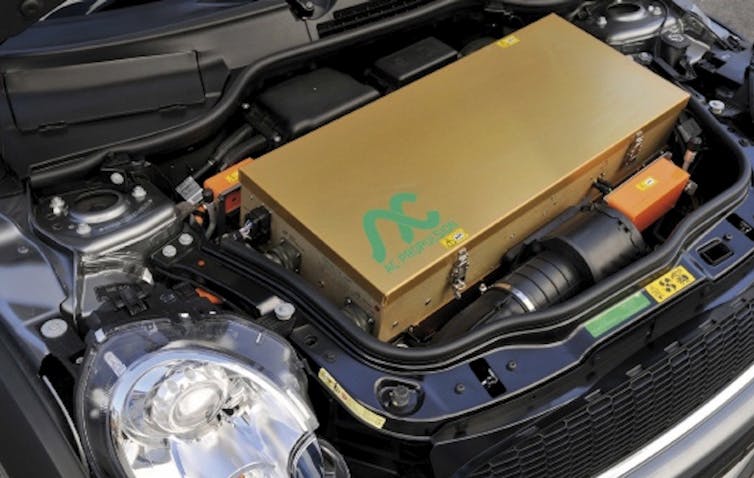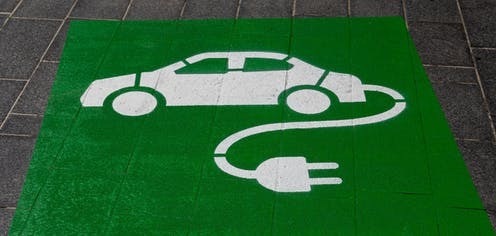Between 2000 and 2018, the number of lithium-ion batteries (LIBs) manufactured was multiplied by 80. In 2018, 66% of them were used in electric vehicles (EVs). The planned development of electric mobility will increase demand for batteries, with the International Energy Agency estimating that between 2019 and 2030, battery demand will grow 17-fold.
This situation raises many questions related to the materials used to manufacture these batteries: what resources are involved? What are the environmental impacts of extracting them? Can they be recycled?
When looking into the materials in the LIBs that are currently used in the vast majority of EVs, the first thing to know is that there are multiple kinds of battery technology. While all contain lithium, the other components vary: batteries in telephones or computers contain cobalt, whereas those for vehicles may contain cobalt with nickel or manganese, or none at all in the case of iron-phosphate technologies.
The exact chemical composition of these storage components is difficult to identify, as it is a trade secret. Furthermore, improvements are regularly made to batteries to increase their performance, so their chemical composition evolves over time. In any case, the main materials involved in manufacturing LIBs are lithium, cobalt, nickel, manganese and graphite. These have all been identified as materials presenting supply and environmental risks.
The question of supply for these materials is a complex one: on the one hand, the value of reserves is subject to geopolitical considerations and evolutions in extraction techniques; on the other, needs for materials are very sensitive to hypothetical forecasts (number of EVs and battery size).
What are the environmental impacts?
The question of the environmental impacts of battery manufacturing is perhaps even more important. Even if there are enough materials, the impacts of their use must be seriously considered.
Studies show that battery manufacturing can have serious impacts in terms of human toxicity or ecosystem pollution. On top of this is the need to monitor labour conditions in certain countries. Furthermore, analysing environmental impacts requires full knowledge of battery composition and manufacturing processes, but this information is difficult to obtain for obvious reasons related to industrial property.
Could recycling the materials provide solutions to limit these risks and impacts?
There are two main families of battery recycling processes, used separately or in combination.
-
Pyrometallurgy, which destroys the organic and plastic components by exposing them to high temperatures and leaves only the metal components (nickel, cobalt, copper, etc.). These are then separated by chemical processes.
-
Pydrometallurgy, which does not include the high-temperature stage. Instead, it separates the components only by different baths of solutions that are chemically adapted to the materials to be recovered.
In both cases, the batteries must first be ground to a powder. The two processes currently operate on an industrial scale in recycling LIBs for telephones and laptops to recover the cobalt they contain. This material is so precious that recovering it ensures the economic profitability of the current LIB recycling sector.
But as the LIB technologies used for EVs do not all contain cobalt, the question of the economic model for recycling them remains unresolved, and there is still no real industrial sector for recycling these batteries. The main reason is the lack of a sufficient volume of batteries to be processed: the widespread roll-out of EVs is relatively recent and their batteries are not yet at the end of their life.
Furthermore, the definition of this end of life is in itself subject to discussion. For example, “traction” batteries (which allow EVs to run) are considered unfit for service when they have lost 20 or 30% of their capacity – which corresponds to an equivalent loss in the vehicle’s autonomy.
Can EV batteries have a second life?
There is a debate around a potential “second life” for these batteries, which would make it possible to extend their use and thereby reduce their environmental impacts. The first issues for this relate to the reconfiguration needed for batteries and their electric monitoring mechanism. Next, applications must be identified for these batteries with “reduced” capacity. They could be used for energy storage connected to the electricity network, as many experiments have been run in this area.

Certain EV batteries could be reused in solar farms for example – an economic and environmental model that has been widely discussed. Here, the battery of an eMini. Underway in Ireland/Flickr, CC BY-NC-SA
However, a major player such as RTE, the operator and manager of France’s electricity transmission network, believes that this application is ill-suited, functionally and economically, and recommends recycling EV batteries at the end of their first life instead.
Setting up a recycling sector that can adapt alongside evolving technologies
Establishing a recycling sector will also require an economic model capable of adapting to the range of battery technologies, without having to use a large number of different recycling processes.
Lastly, it must be noted that these environmental impact and recycling issues are not simple to tackle, as the technologies have not yet reached maturity and their long-term sustainability is not yet guaranteed. LIBs evolve very quickly – with lithium-metal battery technologies now being designed, for example – and we are even seeing the arrival of competing technologies without lithium, such as sodium-ion.
For all these reasons, the environmental, economic and social impacts of manufacturing and recycling EV batteries and their materials must continue to be studied. It is essential to keep applying grassroots and legislative pressure to obtain transparency around manufacturing processes, so that we can quantify their impacts and identify ways to limit them. Forthcoming European research programmes are also positioned in this area, including the environmental dimension of new battery development.

The way to limit the use of electric batteries is to limit the size and power of motor vehicles. Filip Mroz/Unsplash, CC BY
However, we should not just sit around waiting for some miraculous, clean, high-performing and cheap battery technology, which is more like a pipe dream. It is important that we slow down the growth in EV battery size, and therefore limit the power, mass and autonomy of the vehicles themselves.
This means we will need to rethink how we get around – leaving the car-based model – rather than seeking to replace one kind of technology (the combustion motor) with another (the electric motor).



 SpaceX Insider Share Sale Values Company Near $800 Billion Amid IPO Speculation
SpaceX Insider Share Sale Values Company Near $800 Billion Amid IPO Speculation  Trump Administration Reviews Nvidia H200 Chip Sales to China, Marking Major Shift in U.S. AI Export Policy
Trump Administration Reviews Nvidia H200 Chip Sales to China, Marking Major Shift in U.S. AI Export Policy  SUPERFORTUNE Launches AI-Powered Mobile App, Expanding Beyond Web3 Into $392 Billion Metaphysics Market
SUPERFORTUNE Launches AI-Powered Mobile App, Expanding Beyond Web3 Into $392 Billion Metaphysics Market  Republicans Raise National Security Concerns Over Intel’s Testing of China-Linked Chipmaking Tools
Republicans Raise National Security Concerns Over Intel’s Testing of China-Linked Chipmaking Tools  7-Eleven CEO Joe DePinto to Retire After Two Decades at the Helm
7-Eleven CEO Joe DePinto to Retire After Two Decades at the Helm  Citi Appoints Ryan Ellis as Head of Markets Sales for Australia and New Zealand
Citi Appoints Ryan Ellis as Head of Markets Sales for Australia and New Zealand  Dina Powell McCormick Resigns From Meta Board After Eight Months, May Take Advisory Role
Dina Powell McCormick Resigns From Meta Board After Eight Months, May Take Advisory Role  iRobot Files for Chapter 11 Bankruptcy Amid Rising Competition and Tariff Pressures
iRobot Files for Chapter 11 Bankruptcy Amid Rising Competition and Tariff Pressures  Oracle Stock Surges After Hours on TikTok Deal Optimism and OpenAI Fundraising Buzz
Oracle Stock Surges After Hours on TikTok Deal Optimism and OpenAI Fundraising Buzz  TikTok U.S. Deal Advances as ByteDance Signs Binding Joint Venture Agreement
TikTok U.S. Deal Advances as ByteDance Signs Binding Joint Venture Agreement  MetaX IPO Soars as China’s AI Chip Stocks Ignite Investor Frenzy
MetaX IPO Soars as China’s AI Chip Stocks Ignite Investor Frenzy  Apple Opens iPhone to Alternative App Stores in Japan Under New Competition Law
Apple Opens iPhone to Alternative App Stores in Japan Under New Competition Law  U.S. Lawmakers Urge Pentagon to Blacklist More Chinese Tech Firms Over Military Ties
U.S. Lawmakers Urge Pentagon to Blacklist More Chinese Tech Firms Over Military Ties  Intel’s Testing of China-Linked Chipmaking Tools Raises U.S. National Security Concerns
Intel’s Testing of China-Linked Chipmaking Tools Raises U.S. National Security Concerns  OpenAI Explores Massive Funding Round at $750 Billion Valuation
OpenAI Explores Massive Funding Round at $750 Billion Valuation  Volaris and Viva Agree to Merge, Creating Mexico’s Largest Low-Cost Airline Group
Volaris and Viva Agree to Merge, Creating Mexico’s Largest Low-Cost Airline Group  SpaceX Begins IPO Preparations as Wall Street Banks Line Up for Advisory Roles
SpaceX Begins IPO Preparations as Wall Street Banks Line Up for Advisory Roles 





























